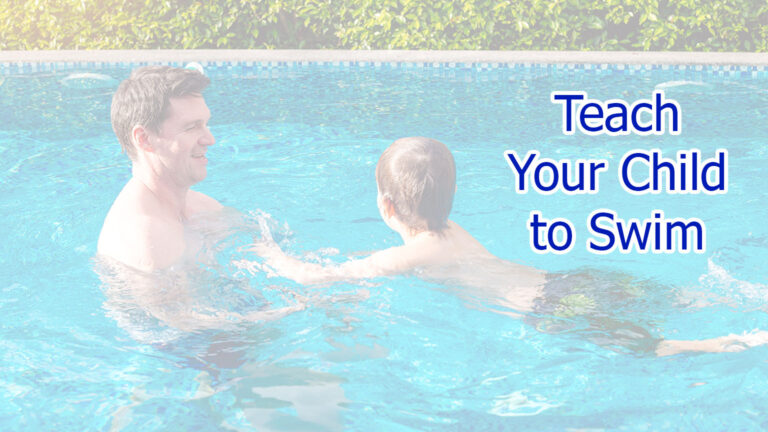Everyone wants their children to learn to love the water, learn to swim and of course, to be safe in the water, that’s why swimming lessons for children are so popular. However you don’t need to wait until your child attends school swimming lessons or pay for expensive private lessons in order to help your children learn to swim – in the comfort of your own pool at home.
These tips and activities will help you to encourage your children to become confident, competent swimmers!
Table of Contents
Develop a Love of Water
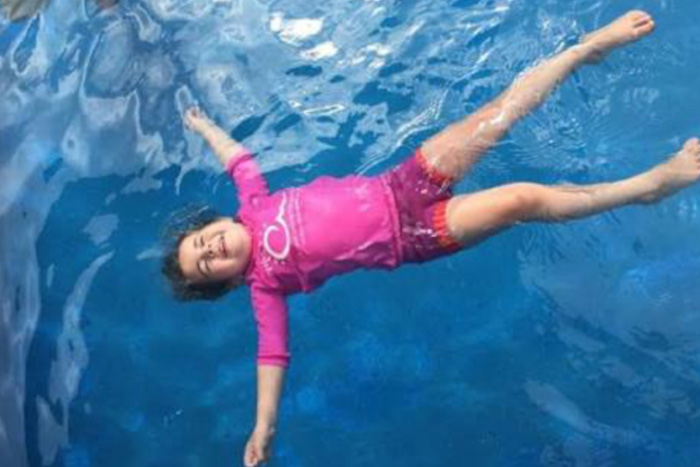
The first step to teaching swimming is to encourage a love of water. You can do this in a number of ways:
- Making bath time fun for little ones, not something that is pressured and stressful.
- Giving little children lots of opportunity for water play. Even just playing with a tub of cups and funnels, boats and sieves allows them to increase their understanding of how water works and feels.
- Get a paddling pool for little ones to give them lots of chances to run and splash and lay in the water. Always supervise children around water, even when it’s only ankle-deep.
- Provide opportunities for children to experience different types of water environments as much as possible. If children grow up having been to the pool, the beach or river and enjoy fun times at those places, they learn to associate water with enjoyment.
- Model enjoyment. If you have a fear of the water, work on yourself so that you don’t pass that onto your children. Children learn what they observe.
- Consider ear issues. For some children, getting water in their ears can be very uncomfortable or lead to painful swimmer’s ear. Using a product like Ear Band-Its works for all ages and helps children with sensitive ears enjoy the water more.
- Build trust – never break your promise to a child when it comes to water. Don’t tell them you won’t let them go, but then let them go or try to trick them. Children need to feel safe and secure with you in the water!
- Be playful! Have fun, laugh, play games and enjoy spending time with your children in the water.
- There’s no rush to teach your child to swim. There’s no glory in having an “early swimmer” if your child ends up terrified of water or stressed about swimming. It’s much better to take things at a slower pace and take time to help your children develop swimming skills than to push them too fast or expect too much and have them develop reluctance.
Safety First
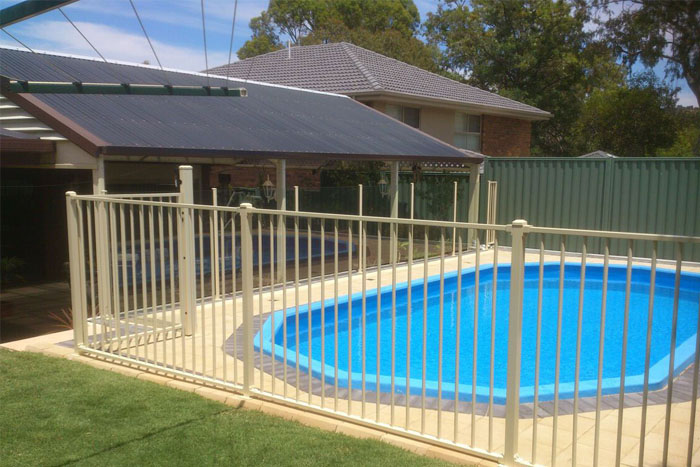
The very first rule of safety around water is to never, ever leave children unattended. It doesn’t matter how old they are, there should always be an adult nearby. Even teens may need supervision, depending on the situation. Drowning is silent and can happen very fast. Children who are drowning may not make a sound, splash about or be able to call for help. Always be vigilant.
Here are some other tips for pool safety that will ensure that your child learns to swim in a safe environment and learns safety strategies too!
Babies
- Always keep your baby in your arms. Babies should not be wearing floatation devices but should be held by their parents.
- Do not submerge any child under 3. Kids this age can swallow a large amount of water — enough to dilute the chemicals in their blood, causing sleepiness, nausea, and seizures. In rare cases, water intoxication can be fatal.
- Always make sure your pool is fenced in on all sides and has a self-closing, self-latching gate that’s out of your child’s reach. The fence should be four to five feet high and should not have any footholds. A fence is an absolute must if you have a pool.
- Beware of any water with babies. They can drown in as little as an inch of water in less than 30 seconds, so be aware of all inflatable baby pools, buckets, toilets, and tubs.
- Keep rescue equipment such as a plastic ring buoy, a reaching pole, a first-aid kit, and a portable phone – near the pool.
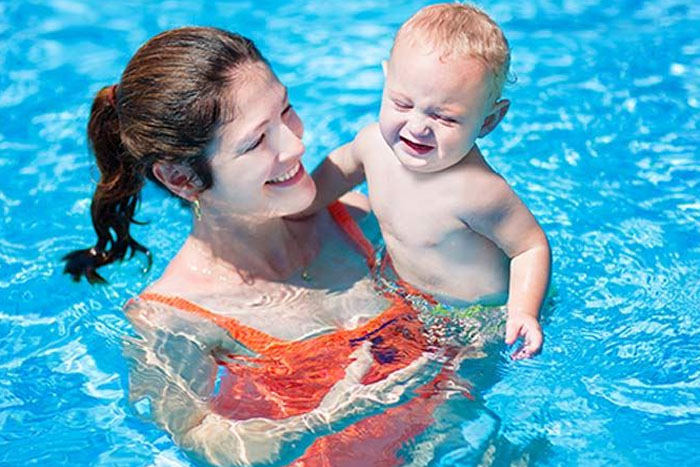
Toddlers
- Toddlers may become comfortable in the water and think they can swim on their own. Don’t ever leave a toddler alone, even for a minute.
- Make sure the pool gate is always closed and the lock is out of reach.
- Make sure you reinforce safety rules around water over and over, such as not running near the pool and only going into the water with Mommy or Daddy.
- Avoid water wings, air-filled swim suits and inflatable flotationtoys. These items can give children a false sense of confidence and let them think they can do things that they actually can’t. They can also be very dangerous if they deflate. Some devices can be lethal if a child tips over with their face in the water – a floatation ring or jacket can actually hold them down and make it hard for them to right themselves or get their head out of the water.
- Don’t leave toys in the pool as they may tempt a child to find a way to get over the pool fence!
Pre-school Children
- Always stay within reaching distance of children this age.
- Be patient and don’t force children to do an activity until they are ready.
- Make sure your pool has the deep and shallow ends marked. A lifeline separating the two ends is a good idea.
- Never assume another adult is watching, even if a lifeguard is present.
- Teach children what to do if they fall in the water – try to stay calm, paddle their arms and legs, reach for an edge and reinforce this with them.
School-aged Children
- Ensure that children are still supervised at this age – even a good swimmer can drown.
- Make it a rule that your child can swim only when an adult is present.
- Teach children to dive only when an adult is watching and the water is deep. Teach diving and jumping safety rules to avoid head and spinal injuries.
- You should be extra vigilant at the beach or a lake. A child’s swimming skills in a pool don’t necessarily translate to open water.
- Always make your child wear a lifejacket when boating or canoeing or waterskiing, even if he or she can swim.
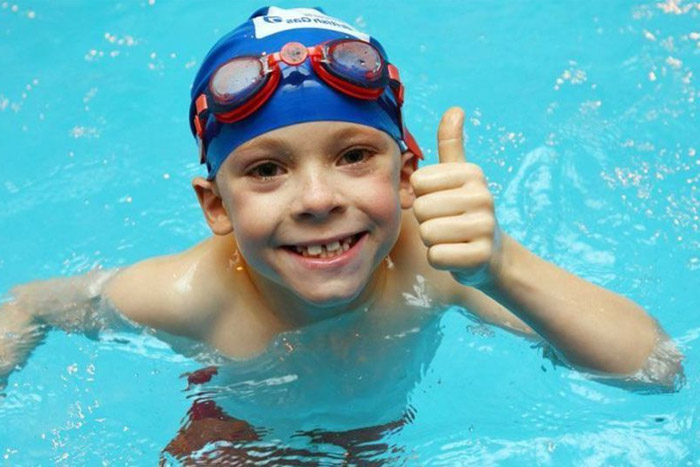
Consider Age
It’s important to consider the age of your child when doing water activities with them. Here are some tips for encouraging good swimmers at each age and stage of development.
Babies
When children are little, you just want to introduce them to the water. Play in the pool and the bath. Focus on having fun and getting comfortable in the water, not learning to swim. Show children how to splash, sing songs while bobbing around, and play gentle games together.
Toddlers
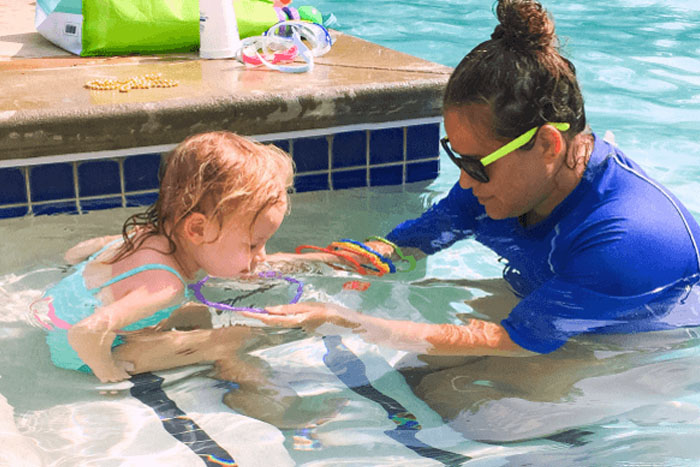
Toddlers will certainly be more active in the water but will definitely still need an adult to help them. In the pool, play fun games that require children to move their arms (throw a ball across the pool and have them reach for it, for example), kick their legs, and float supported on tummy or back. Show toddlers how to blow bubbles in the water so they learn to get their face wet without swallowing water.
Pre-school Children
At this age, you may want to enrol your child in swimming lessons in addition to developing skills at home. You may be able to take part in your child’s first class to make the transition easier. Make sure you shop around and find a class with an instructor your child feels comfortable with and is happy in. At home, in the shallow water, help your child to learn how to float independently, to submerge their head under the water for five to ten seconds, go from a standing to a swimming position without assistance, glide through the water, and use coordinated kicking and arm movements. Children this age should definitely also be learning water safety skills!
School-aged Children
Older children should be practicing holding their breath for longer periods of time, swimming underwater and retrieve objects at the bottom. They will be able to jump into the water and resurface on their own. School-aged children can start learning all of the swimming strokes, including the breaststroke and backstroke. At this point, you don’t have to be in the water with your child all the time, but you still need to supervise pool activities and stay within reach of children.
Build Skills through Activities
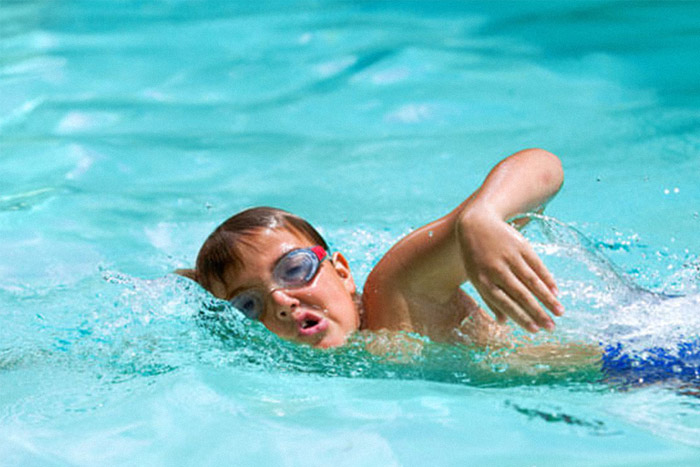
Here are five basic activities that you can do with children in order to teach skills that form a vital foundation for learning to swim. You can find lots more ideas for skills-building activities in books and online.
-
Talk to the turtles
Practise talking to pretend turtles (or whatever water creature your child likes) by getting your kids to blow bubbles in the water. Then ask them to put their ear in the water to listen to the pretend response. This teaches breath control and increases a child’s comfort level in the water. One great tip is to show children how to blow bubbles by submerging your whole face in the water and then coming up with a smile and laugh. Show that it’s great fun!
-
Let’s Go Fishing
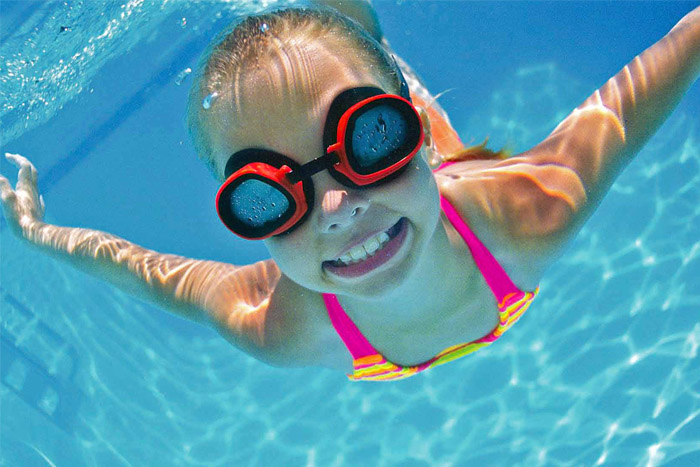
Sit next to your child on the steps of the shallow end, or stand facing each other if the pool is shallow enough, and ask your little one to try to catch fishies with their hands. Ask children to perform a front-crawl-like arm stroke by reaching his arms up in the air, plunging them into the water, and then pulling the water toward themselves, as if there were lots of fishies in the pool that they are pulling toward their bodies. Ask kids how many fishes they caught and then get them to pretend to throw them back into the water.This swimming pool game helps in developing a fast, strong arm motion. Make sure your child is performing this activity with fingers together, so the fishies don’t escape between their fingers. This will help with propulsion when they starts swimming on his own.
-
Straight and Tall Rockets
Once children can float on their front, get them to push off with their legs from a wall as hard and fast as they can with their arms outstretched in front of them. They shoot off like rockets, keeping their bodies as flat as they can horizontally the water. Encourage them to take a breath and keep their head down while they zoom. You can also get them to try it with their heads up and feel that it’s harder for their body to zoom and they don’t go as far as they do with their head down. For this game, they don’t need to kick, just push off and zoom until they stop and then show them how to put their feet down to touch the bottom and stand up.
-
Speed Boat Front Float
Securely hold your child under their arms, facing you. Start walking backward through the water. As you pick up a little speed, the water will gently push them into a front float position. Spin slowly in a circle and chant, “Speedboat, Speedboat, Go So Slow.” Encourage them to kick slowly. Pick up a little speed and say, “Speedboat, Speedboat, Go So Fast.” Encourage them to kick fast. With the last line “Speedboat, Speedboat, Step on the Gas!” have your child blow bubbles too.
-
Taking the plunge
In the shallow end, crouch two feet away from the wall, and hold your child so they are standing on your knees, your hands supporting his waist (you are both facing the wall). Ask them to jump off your knees and grab on to the wall. The first few times, they will not actually be swimming, but using the propulsion from his jump to get to the wall. This technique slowly gets your child used to swimming independently. Let them hang on to the wall for a moment so he can get used to supporting his body weight until you come over and grab him to try it again.
Gradually increase your distance from the wall, reminding your child to catch the fishies with their hands and kick their feet. They may struggle the first few times, but keep encouraging them and applauding his progress and, very soon, you will have a great little swimmer on your hands!
Teach Good Habits
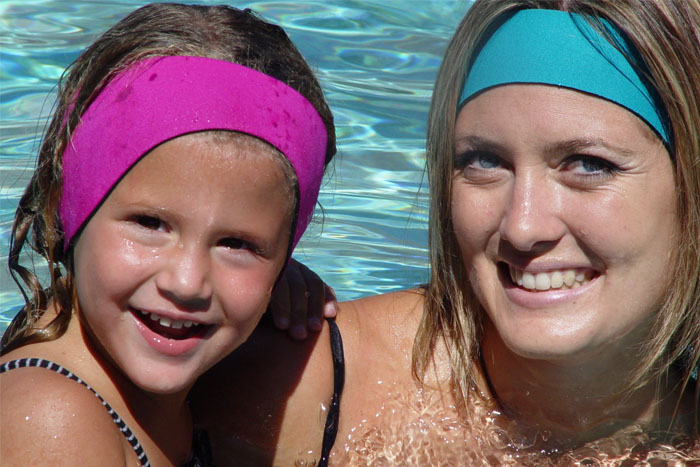
If you are teaching your child to swim yourself, do some research about correct swimming technique. When children are little, it’s just about building confidence, enjoyment and basic skills such as blowing bubbles, kicking and so on. But when children can float and are starting to learn strokes, make sure that they are doing it correctly. You can do this by watching tutorials on YouTube or from online swim schools. There’s also books and lots of other online resources available to help you learn correct technique to teach children.
Here are a few very important points of technique though:
A) Body Position with Floating
When children are floating on their back, they must have their heads back, not holding them up. A great activity for teaching this is to have children lay on their back in the water with you holding them with one hand under their back. Have them put their head right back and relax. When they are ready, remove your hand and say “head up” and get them to put their head up but try to keep floating. Their body will automatically bend and start to sink. Discuss this with them and discuss how when doing back stroke, it will be much easier with their head back.
Do the same activity with front float. Again, they should be able to feel the difference between front-floating with head down and head up. Discuss how it’s much easier to swim with your head down. Play games with your child to help them develop a nice, horizontal body position.
B) Swimming with Face in the Water
Always encourage your child to swim with their face down, turning their head to the side for freestyle or up to take a breath for breast-stroke. They should never be trying to do freestyle or breast-stroke with their head out of the water. This is a really important technique to ensure that children develop.
C) Blowing Out While Face is in the Water
A bad habit that some children develop is to hold their breath while their face is in the water and then when they lift their head, they are trying to breath out AND in at the same time. Help them to practice blowing out while their face is in and taking a breath when they turn their head to develop a rhythmic breathing technique.
D) Kicking Technique
Watch videos on kicking technique so that your child doesn’t develop an inverted kick or an odd kicking technique that may be very hard to break down the track.
Swimming lessons is a great idea for children when they’re ready for them, but there’s still a lot you can do to teach your child to swim at home. Be creative, have fun, be safe and enjoy spending time in the water with your children and you will soon have confident and competent swimmers with great water skills!

